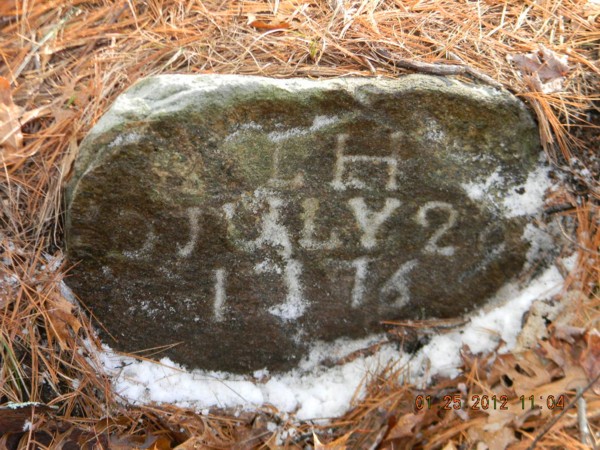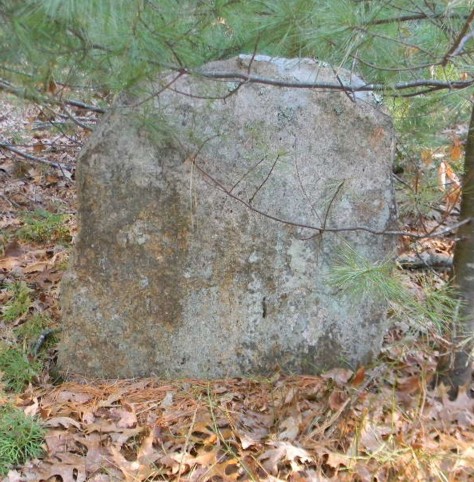
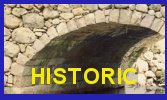

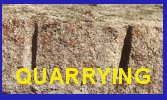
Field Stone Gravestones
Introduction
In New England, the vast majority of gravestones were done by professional gravestone carvers. In some rural communities where the services of a gravestone carver were not available or when a family was too poor to afford to purchase one, the family had two choices (1) erected a wooden grave marker (2) erected a rough field stone. Rough field stones used for grave markers usually have at least one flat face. Occasionally, they have an inscription carved on the flat face but most were blank. West Greenwich, Rhode Island has two examples of rough field stone with inscriptions and several examples without inscriptions.
Preserved Hall Cemetery, West Greenwich, RI
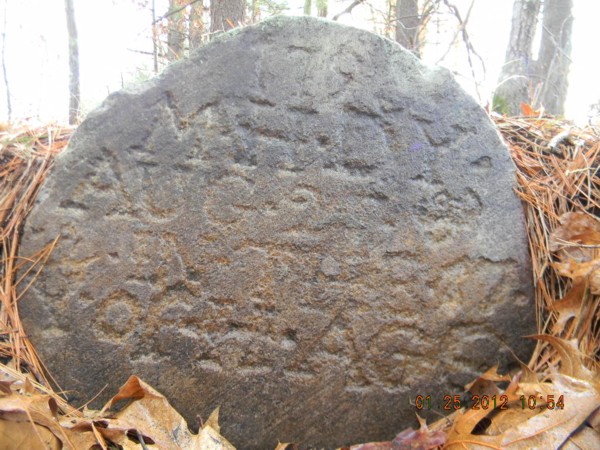 |
Gravestone #1 (1798) - Photo Courtesy of Steve Dimarzo
1798
M. H. DY. [Mary Hall Dyed (died)]
AUG. 2- [August 28]
. IN. THE. -7. [in the X7]
Y. of. H. AGE [Year of Her AGE]
Gravestone #2 (1776) - Photo Courtesy of Steve Dimarzo
L H [L. Hall]
D JULY 29 [Died July 29]
1776
These are two field stone gravestones located in the Preserved Hall Cemetery off of Nooseneck Road in West Greenwich, RI (RI Cemetery WG23). This was a family burial ground for the Hall family. The cemetery has thirty burials. 28 of the gravestones have been transcribed and are available in Rhode Island Cemetery Database. The database records note the presence of these two field stone gravestones but they have never been transcribed unlike the other 28 which have.
Gravestone #1 is partially degraded and the inscription is difficult to read in places. Two numbers indicated by a dash in the above transcription are undecipherable. Who was M. H.? The book “Rhode Island Deaths and Burials 1802-1950” lists a Mary Hall, died Aug 28, 1798 whose spouse was William [Hall] (page 64). Mary’s maiden name is not recorded. “Gardner History and Genealogy” lists the marriage of Mary Gardner and William Hall on August 25 1754 (page 85). Various online genealogical sites listed the marriage as taking place in Exeter, RI which borders West Greenwich. The evidence strongly suggests that M. H. was the Mary Hall who died in 1798. However, at present there is not sufficient evidence to concretely link Mary Gardner to the Mary Hall.
Gravestone #2 is in good condition and its inscription can be fully read. It is reasonable to conclude that this was another member of the Hall family. The identity of L. Hall is unknown. There are no death records for a Hall in 1776 in Rhode Island. It may be a burial for an infant or young child.
Analysis
These are both home-made gravestones. Home-made gravestones are rare for this time period. Most gravestones from this time period were made by professional carvers. Either a gravestone carver was not available or the family was too poor to purchase professionally carved stones.
The lettering style, the use of abbreviations on both stones, and the use of dots in the 1798 stone are consistent with 18th century gravestones. The dropping of the 9 in the “29” below the height of the 2 is a common variation for this period. The use of abbreviations and completely spelled out words on the same stone is common. The abbreviation “DY” is rather unusual. It is an abbreviation for “dyed” which is simply the word “died” spelled out phonetically.
Both were carved with a small chisel ut by different carvers. The 1798 uses dots to indicate the spaces between words, letters, and abbreviations and the 1776 does not use them. There are also differences in how the letters and numbers are formed. The number two is a good example of these differences.
On both stones the lettering seems to have been carefully planned out in advance. On the 1776 stone the three lines of text are carefully centered on the stones. On the 1798 stone the lettering is crammed but it all fits into the available space. (None of the letters were shortened to make them fit.) On both stones the spacing between the letters is a bit off, and not all of the letters are perfectly vertical, some tilt at a slight angle. The chisel work on the 1798 is a bit rough, due in part to the poor quality of the stone. It is clear that neither carver was trained in lettering. However, both stones are competently done.
Uriah Frankin Jr. Cemetery, West Greenwich, RI
The Franklin family cemetery (RI cemetery WG88) contains a mix of professionally carved slate and marble gravestones. The cemetery also contains a row of fieldstone gravestones with no inscriptions on them. Who is buried in these graves is a mystery. It is likely these graves were the earliest interments in the cemetery. Most field stone gravestones are like these examples, they lack any type of inscription.
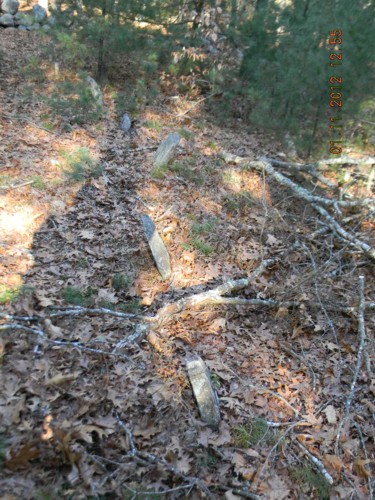 |
A row of field stone gravestones - Photo Courtesy of Steve Dimarzo
One of field stone gravestones in the row - Photo Courtesy of Steve Dimarzo
Ipswich, MA
This fragment of slate stone is fitting into a slot in the base stone. It is inscribed with:
E L
AE 48 [Age 48]
1647
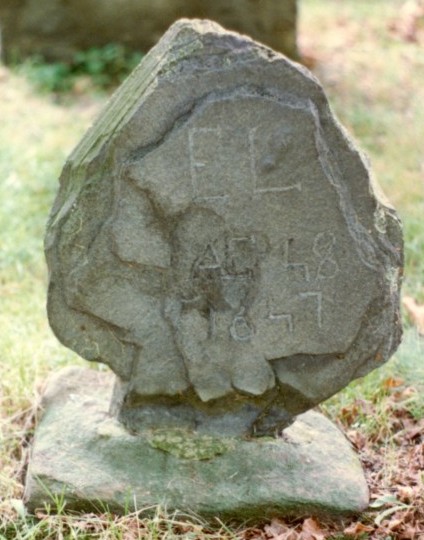 |
Photo by Mary Gage


